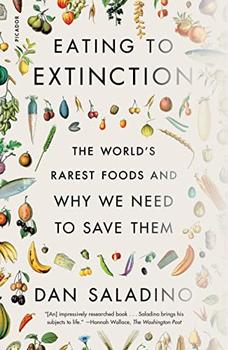Summary | Excerpt | Reviews | Beyond the Book | Readalikes | Genres & Themes | Author Bio

The World's Rarest Foods and Why We Need to Save Them
by Dan Saladino1
Hadza Honey
Lake Eyasi, Tanzania
It was April, the rainy season. Short downpours had brought pockets of colour to the greens and browns of the East African savannah as small delicate flowers bloomed. Nectar was becoming abundant and, with it, honey. I was with a group of Hadza hunters, a scattered population of just over one thousand people. The tribe has lived in the dry bush of northern Tanzania, near the shore of Lake Eyasi, for tens of thousands of years, perhaps hundreds of thousands of years. Now, fewer than two hundred Hadza live fully as hunter-gatherers, making them the last people in Africa to practise no form of agriculture. The group I was with had walked far away from the camp and deep into the bush, led by a young man named Sigwazi. As he walked, he whistled.
This wasn't a melodious tune, more a series of angular ups and downs on a musical scale, each passage finished with a high-pitched twirl. To my ears there was no obvious musical pattern to follow but something in the bush was paying close attention to this whistle. Noticing movement above the trees, Sigwazi broke into a sprint, weaving through the scrub and around baobab trees as he continued the whistle. A wordless conversation was under way, an exchange between a human and a bird. Sigwazi looked towards the flutter of activity in the canopy, and there perched on a branch was an olive-grey bird the size of a starling.
Barring a few flashes of white on its tail, the bird looked plain and unassuming, but after a few more whistles from the hunter, it revealed itself to be exceptional. 'Ach-ech-ech-ech' came its reply to Sigwazi's whistle, signalling that a deal was on. The bird had agreed to lead the hunter to honey hidden among the branches of the giant baobabs. These trees are as wide as they are tall, living for up to a thousand years, fed by a root system so deep that they can access water in periods of extreme drought. Finding a bees' nest concealed among the baobab's tall branches can take a hunter-gatherer several hours as they need to inspect tree after tree; with the assistance of a honeyguide, it takes a fraction of that time. The bird's scientific name captures its talent perfectly: Indicator indicator.
Somehow, over hundreds of thousands of years, the two species, humans and honeyguides, found a way of sharing their different skills. The bird can find the bees' nests but can't get to the wax it wants to eat without being stung to death. Humans, meanwhile, struggle to find the nests, but armed with smoke can pacify the bees. Theirs is the most complex and productive of any partnership between humans and wild animals.
To reach the most isolated Hadza camps from Dar es Salaam, Tanzania's largest city, involves an eighteen-hour drive by jeep. Their home is set among a patchwork of shrubs, rocks, trees and dust, a landscape occupied by humans for at least 2 million years. Looking out across the horizon of Hadza country, it's possible to see human history in microcosm. Just a few miles north is Laetoli, the site where a group of our distant ancestors walked through wet volcanic ash and left behind the earliest known human footprints. Even closer is the Olduvai Gorge, the place where some of the oldest stone tools and hand axes have been discovered. Within walking distance is the saltwater expanse of Lake Eyasi, where human skeletons, 130,000 years old, have been excavated.
The Hadza are no proxy for our Stone Age relatives; they are thoroughly modern humans. But their foraging way of life is the closest we have to that of early Homo sapiens, and the Hadza diet offers the best insight into the foods that fuelled our evolution. I watched the Hadza follow trails that were impossible for me to see, and read the earth as if it was a much-loved book, knowing exactly where golden Congolobe berries were ripest and Panjuako tubers were at their thickest, where long-snouted bush pigs were likely to feed and when the squirrel-like hyrax might gather. They picked up on sounds I didn't notice and paused to feel changes in the gentlest of breezes so they could approach animals undetected. It was still a month until the dry season, when the large game congregate around water, making them easier to find. For now, the easiest way of finding meat was to dig it out from underground, which is why earlier Sigwazi had lured a porcupine from its den beneath a baobab tree. The offal (the heart, liver and kidney) were eaten on the spot, cooked for moments on a makeshift fire, but the carcass was carried back to camp, and shared among the rest of the group. Meat, however, isn't the Hadza's favourite food. Honey is, which is why the conversation with the honeyguide is so valuable.
Excerpted from Eating to Extinction by Dan Saladino. Copyright © 2022 by Dan Saladino. Excerpted by permission of Farrar, Straus & Giroux. All rights reserved. No part of this excerpt may be reproduced or reprinted without permission in writing from the publisher.
The secret of freedom lies in educating people, whereas the secret of tyranny is in keeping them ignorant
Click Here to find out who said this, as well as discovering other famous literary quotes!
Your guide toexceptional books
BookBrowse seeks out and recommends the best in contemporary fiction and nonfiction—books that not only engage and entertain but also deepen our understanding of ourselves and the world around us.